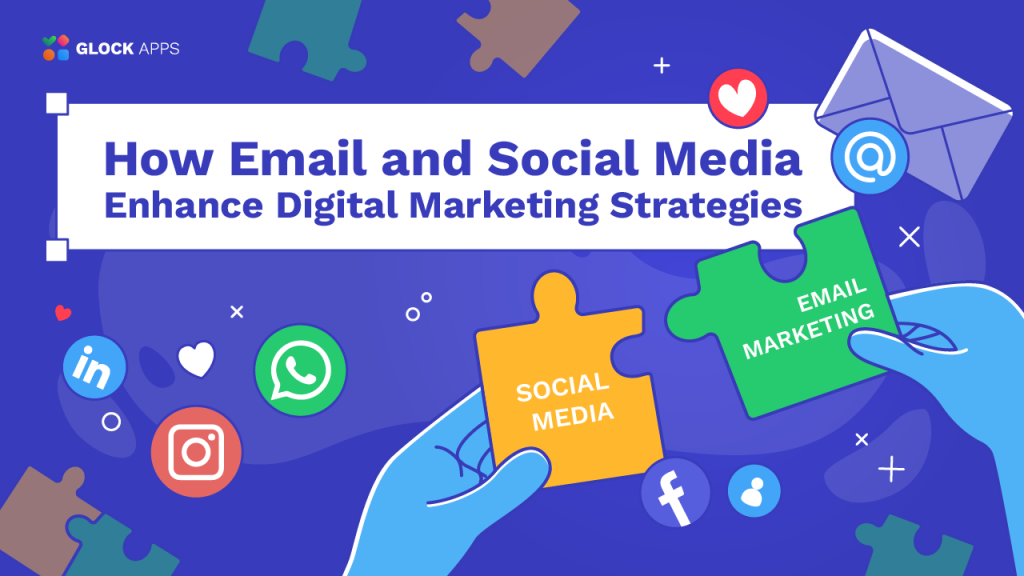How Email and Social Media Together Enhance Digital Marketing Strategies

Estimated reading time: 5 minutes
Social media marketing and email marketing have become the backbone of a digital marketing strategy. When people think of their role in marketing, they frame it in a comparison like “email marketing vs social media”. So, in order to take advantage of these different channels, it’s best to understand how they complement each other and how using them together can take your brand’s messaging to the next level. So, let’s delve into the relationship between social media marketing and email marketing, and see how the two can be used together to maximize results!
The Complementary Nature of Social Media and Email Marketing
If you have heard debates around social media and email marketing, here’s a nice middle-of-the-road idea: they are complementary platforms, each useful for very different aspects of the digital marketing ‘ecosystem’. Social network platforms are great for live engagement, brand presence, and content virality. They facilitate dynamic, public interactions – great for building community and brand personality.
On the other hand, email marketing enables you to undertake direct marketing with a much higher degree of personalization to a targeted group of recipients. The message conveyed via email can be carefully personalized to reflect the individual flavor of customer needs and behaviors, thus creating higher relevance and winning greater loyalty.
Harnessing the Strengths of Both Channels
1. Data Integration and Enrichment.
The primary benefit of social media and email integration is undoubtedly the opportunity that cross-channel data analysis provides. Such insights can be gathered from responses to email campaigns and social-media interactions to tailor more precise audience segments. For instance, a follower’s engagement on social media could trigger a personalized email, further nurturing that lead.
2. Content Amplification.
With ‘social media emails’, focused content could have a wider span. Marketers can experiment with publishing content on both their social media and email marketing channels. You can give exclusive access, news, or preview of what’s in store via email – and give a sneak peek on the social media platform and vice versa. Exclusive content through email can be pre-announced on social media to create a buzz – and have people subscribe. Meanwhile, social media posts with great reach can be taken to an email newsletter to further communicate and retain engagement.
Stay ahead in email marketing! Subscribe to our newsletter for the latest insights, tips, and industry news
3. Leveraging User-Generated Content.
Emails can feature user-generated content collected through social media, such as customer reviews or photo submissions. This approach not only enriches the content of the emails but also encourages more social media participation as users see their contributions being valued and highlighted.
4. Coordinated Campaigns.
Suppose you are introducing a product or a special promotion on a certain date. In that case, you might want your email and social media marketing campaigns to be presented in a unified way. For instance, you might launch a campaign where social media teases the audience, and emails provide more information or exclusive access.
5. Retargeting and Remarketing.
With the addition of email marketing and social media, sophisticated retargeting strategies can be leveraged: an email recipient who clicked on, for example, a link to a product page could be retargeted on social media again. This would strengthen the chances of conversion. Ensure your emails hit the inbox every time; try GlockApps to test your deliverability!
Overcoming Misconceptions: Is Email a Form of Social Media?
The question ‘Is email a social media?’ is a classic example of how basic digital marketing course fundamental concepts are often misunderstood. To set the record straight, email cannot technically be called social media. By definition, social media are characterized by a certain type of communication that takes place through interactive, public, and open channels between users, who can potentially share ideas and information instantly and widely with one another. By comparison, email is private and direct, and its interactions are by default between a sender and recipients without public visibility afforded by social media platforms.
However, dismissing email as unrelated to social media overlooks its integral role in comprehensive social media strategies. Here are several reasons why email is a crucial component, even if it isn’t “social media” in the traditional sense:
Personalized Engagement
Email excels in delivering personalized content to your customers. Unlike the broad and often impersonal nature of social media posts, emails can be finely tailored using data on past interactions, purchases, and user behavior. This personalized approach mirrors the relationship-building aspect of social media but in a more controlled and intimate setting.
Feedback Loop
Email also acts as a feedback tool that can inform social media strategies. Through metrics such as open rates, click-through rates, and conversion data, marketers gain insights into the preferences and interests of their audience. This information can be used to refine social media content, ensuring that it is more aligned with the audience’s desires and expectations.
Driving Social Interactions
Email marketing can effectively extend its reach into the social sphere by including social sharing buttons and calls-to-action that encourage recipients to follow social media channels, participate in contests, or share content. This strategy not only increases social media traffic and follower counts but also enhances user engagement across platforms.
Conclusion
The dialogue shouldn’t be “email marketing vs social media marketing” but rather how each complements the other. In the dance of digital marketing, social media and email are partners, each enhancing the other’s strengths. By merging email and social media marketing, brands can achieve a comprehensive, integrated approach that reaches audiences wherever they are more effectively. Developing a marketing strategy involves understanding the strengths and limitations of each platform. The strategy should guide how content is repurposed across channels and outline the timing of coordinated posts and emails, ensuring a seamless user experience. Keep your email campaigns on track; use our HTML Checker to eliminate the errors!



